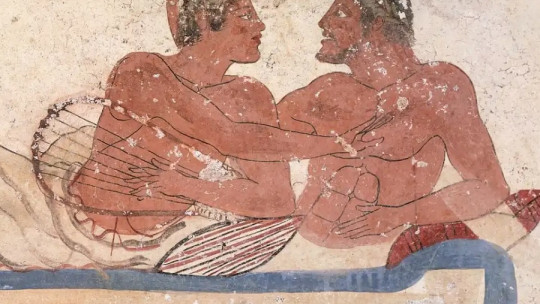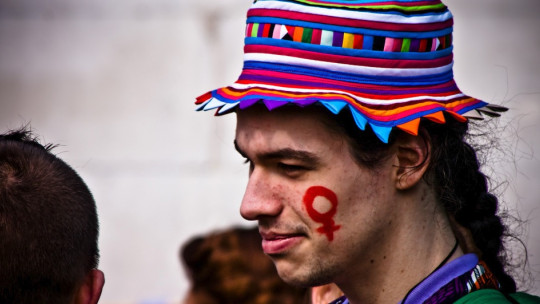
The word homophobia It has Greek roots and is composed of homos, which means “equal,” and phobia, which means “hatred or aversion toward something.” Therefore, we can translate the entire word, literally, as “aversion and hatred of the same”, understood in this case to be relations between people of the same sex.
If we take the definition that homophobia According to the RAE, we find that it is “aversion to homosexuality or homosexual people.” However, today the concept has been expanded, and the word designates a hatred towards any sexual orientation or identification different from the traditional one.
That being said, let’s get to the bottom of this article, in which We wonder if, in Ancient Greece, homophobia existed as we understand it today Let’s see it.
Was there homophobia in Ancient Greece?
Talking about the past based on ideas of the present is quite risky, as it can cause a biased or distorted view of reality. In this sense, we can affirm that homophobia did not exist in Ancient Greece, at least as we understand it today.
Why do we say this? Because we must start from the basis that the concepts homosexuality and heterosexuality They are modern concepts, both born in the 19th century. Therefore, When we talk about Greece it is anachronistic to talk about homosexual or heterosexual relationships
As Miguel Suñén Martín masterfully states in his final degree project Greek love: a study of pederasty as an initiation rite in Ancient Greece (University of Zaragoza), this sexual duality did not exist in Ancient Greek society. People (or rather, free men) could choose to have relationships with the sex they wanted, and there was no difference between the beauty of a young man and a girl, both equally attractive.
However, as we will see below, There were a series of roles that did mark a status and that differentiated what was morally accepted and what was not
Erastes and Eromenos
In Ancient Greece it was very common for a mature man, between 30 and 40 years old, to take a teenage boy under his “protection” and, in addition to instructing him on how to be a good citizen, perform sexual acts with him. Obviously, we are talking about pedophilia, but the truth is that in Ancient Greece this “instruction” was absolutely normalized and was a prestigious institution in Ancient Greece, especially in Athens.
The established man who claimed a teenage lover was called erasteswhile his young companion was called eromenos We emphasize this, since only by knowing the difference in roles can we understand what Greek society (especially Athenian) based its rejection of sexual practices that they considered “despicable.”
We have already said that the erastes had an age between 30 and 40 years, the age that in Ancient Greece was considered the masculine prime of life. It was then that he would choose a young man to “woo”; Numerous poems have been preserved in which he confesses his mad love for the beauty of a boy, and it is known that Erastes sent gifts and showered his intended with luxuries, with the aim of obtaining his favors.
When the young man agreed, and if his family considered erastes convenient for him, the boy became the eromenos, that is, the ward and sexual object of his “protector.” However, what united them both was not just sex, but a filiaan “intellectual friendship”, in which Erastes taught the Eromenos everything he needed to know about life. When, in turn, the eromenos grew (generally, the growth of the beard was established as the turning point), it became erastes and the whole process began again.
Question of roles
Leaving aside the moral, ethical and psychological considerations of such a relationship, we have that, indeed, relationships between adult men and adolescents were fully accepted in Greece. But (there is always a but) they existed two very different roles, which were in fact those that established the “honorability” of the individual
The first of these roles was that of the passive lover, the “controlled”, the “submitted”. This role was limited to the eromenos, and also to slaves and women. In other words: in Greek sexual relations, whoever acted as a passive object was considered immediately inferior.
In a society of warrior origin (remember that the Greeks come from Indo-European tribes), with a clearly patriarchal regime and with an evident and strong social masculinization, the only one who had the “active” role reserved (the only role accepted as “good”). and “superior”) was the free, mature man, the citizen with full rights who decided the destinies of the polis. In this role, therefore, those considered “inferior” had no place, such as young people, slaves or women.
It is important to emphasize that, when we talk about “active” and “passive” roles in Ancient Greece, we do not have to understand only the act of penetration, but that within these roles others of a different nature were included, such as “superiority.” intellectual and higher power status.
Thus, the first step to understand sexual reality in Greek times is to understand that Accepted homosexual relationships occurred exclusively between two men, between whom there was a notable age difference What today we would consider, obviously, pedophilia.
Secondly, it is necessary to emphasize three fundamental elements: age, the type of role played and social status. Only by knowing the prejudices that the Greeks maintained in reference to these three factors can we understand what society based its rejection of a specific sexual practice on. In conclusion, we can say that the sexual practices that were considered “shameful” were those that involved playing a “passive” role, and this included young people, slaves and women.
In this sense, we could talk about a homophobic attitude towards homosexual relations that occurred between two free adults, since one of them had to play the “passive” role that caused so much shame. Greek society therefore accepted a pedophile relationship without too many scruples, while a relationship between two adult men, as equals, was the object of ridicule and homophobic attacks. It may seem surprising, but that’s how it was.
And the women?
At this point, we can ask ourselves if romantic and sexual relationships between women were equally accepted. The answer is a resounding “no”, and in this case we could also talk about homophobia from the current definition.
Ancient Greece was possibly one of the most misogynistic societies in history The woman was not considered a subject with rights in any of the stages of her life; she was always legally and morally bound to a man. In childhood and adolescence, to the father or whoever acts as head of the family in the absence of the parent; once married, to her husband. At the base of this situation is the belief that women were inferior to men and, therefore, incapable of offering the filia “intellectual” that a male lover could give. In short: a woman was just an object whose only role was motherhood and sexual relief.
That is precisely why it is absurd to talk about homosexuality in current terms, since relationships between men did not happen due to a free choice of sexual orientation, as happens now, but due to the limiting belief that women were inferior beings and, therefore, excluded from the possibilities of choice.
This does not mean that men did not have concubines or go to prostitutes; Of course, all this was quite common practice. But, if you remember, in the second section we insisted on the importance of roles. Since, according to the society of the time, women were clearly “inferior,” Only the “passive” role could be reserved for her which corresponded to the “submissive”, comparable, therefore, to the other subjects: slaves and young people.
Therefore, for a lesbian relationship to be consummated, in the mind of the Greek man, one of the two partners had to play the active role. And, if the woman was considered an “inferior” being and, therefore, eternally reserved for a passive role, this meant that, in a lesbian relationship, one of the members of the couple had to adopt a role that was only intended for the men. And a woman transgressing her roles was something that the men of Ancient Greece could not conceive.








